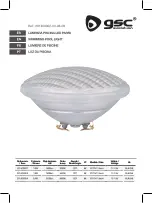
8
3. Operation and maintenance
1. The collectors should feel cool to the touch when the sun is shining on them and water is passing through.
This means that the heat is being transferred to the water.
2. The water returning to your pool will be a few degrees (3-5 degrees) warmer than the pool itself. This is the
most efficient way to heat a large body of water like a pool. Keep circulating the water, which will add a few
degrees each pass.
3. Circulate water through the solar collectors at least 6 hours a day, during the daylight hours on sunny days. If
you circulate water through it at night, when it's overcast or on chilly days, you will cool your pool water rather
than heat it. If you need to run your pump at night, divert the water directly back to the pool and bypass the solar
system. An automatic controller will sense the water temperature and available radiation from the sun and
automatically turn the 3-Way Valve to direct the flow of water accordingly.
4. Winterization
Your solar system must be drained for winterization! Freeze damage is not covered under
warranty. You must drain your solar collectors just like you drain the rest of your pool equipment.
Remove the vacuum relief valve at the top of the solar system. Remove the rubber end cap at the bottom and
be sure ALL water is drained out of the system. Replace the end caps and blow pressurized air in the reverse
direction of the normal water flow. This is the most effective way to drain your system. You can leave the
collectors in place (as long as they are completely drained) and they will withstand even the harshest winters.
However, better is to store your collectors inside in a warm dry place.
5. Repair
If a collector develops a leak
Your solar collectors are warranted against defects in materials and
workmanship. If a leak develops for any other reason, you may use
the repair method shown. The collectors are not warranted against
freeze damage.
Solar collector repair
This method allows for an easy and permanent, on-site repair of a
collector by isolating the leading riser tube. Locate the tube to be
isolated. (In the picture, the end tube is shown for clarity). Using a



































